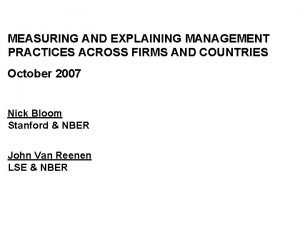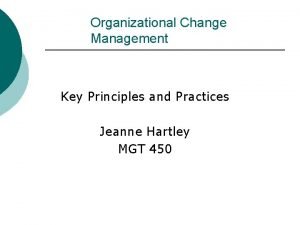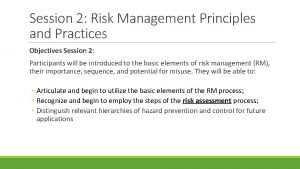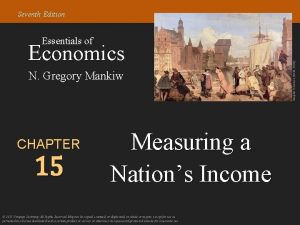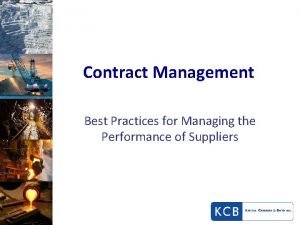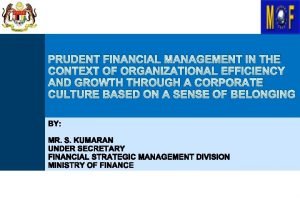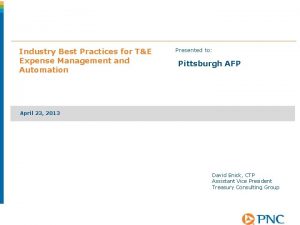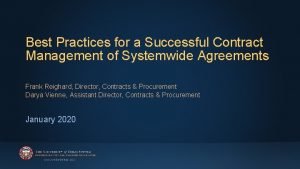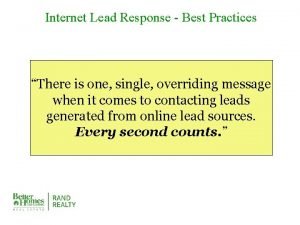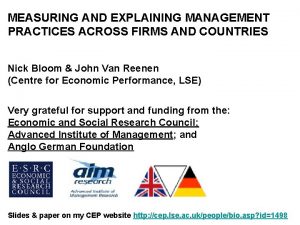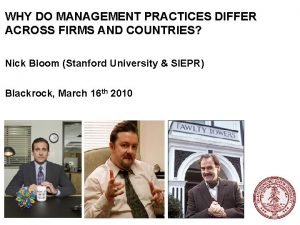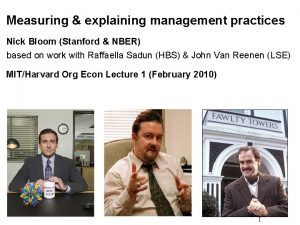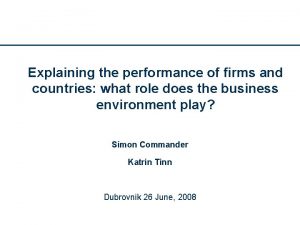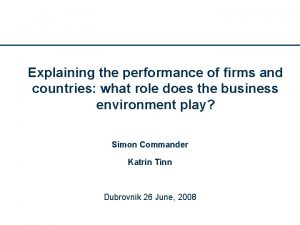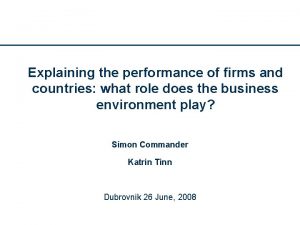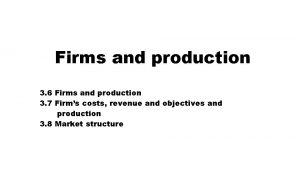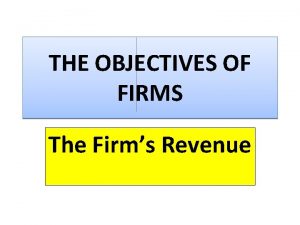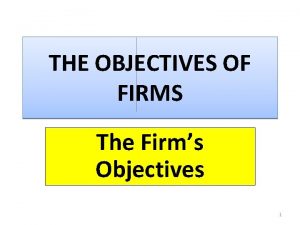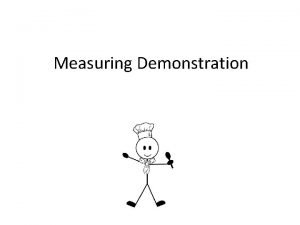MEASURING AND EXPLAINING MANAGEMENT PRACTICES ACROSS FIRMS AND










































![MY FAVOURITE QUOTES: The British Chat-Up [Male manager speaking to an Australian female interviewer] MY FAVOURITE QUOTES: The British Chat-Up [Male manager speaking to an Australian female interviewer]](https://slidetodoc.com/presentation_image/36cb435888095d1b0d31ca1e97258093/image-43.jpg)

![MY FAVOURITE QUOTES: The bizarre Interviewer: “[long silence]……hello, hello…. are you still there…. hello” MY FAVOURITE QUOTES: The bizarre Interviewer: “[long silence]……hello, hello…. are you still there…. hello”](https://slidetodoc.com/presentation_image/36cb435888095d1b0d31ca1e97258093/image-45.jpg)







- Slides: 52

MEASURING AND EXPLAINING MANAGEMENT PRACTICES ACROSS FIRMS AND COUNTRIES October 2007 Nick Bloom Stanford & NBER John Van Reenen LSE & NBER

MOTIVATION Large persistent productivity spread across firms and countries: people typically claim this is due to differences in “management” • But what is the role of management? • And why does it vary so much across firms and countries?

SUMMARY OF THE PAPER (1 of 3) (1) Measuring Management • Develop a survey tool to “measure” management practices • New data on 732 firms in US, UK, France & Germany. • Management data: • Appears consistently measured within firms • Correlated with productivity, profits, Tobin’s Q, growth & survival • Robust to measurement error and bias

SUMMARY OF THE PAPER (2 of 3) (2) Explaining Management • Observe big spread in management practices (Fig. 2 over) • • Wide cross firm spread (like profits & productivity) Significant differences across countries • US 1 st, Germany 2 nd, France 3 rd and UK 4 th • Demonstrate that two factors appear significant: • Production market competition – positive effect • Family managed firms – negative effect • Family firm ownership but not management is fine • Family ownership and management problematic, particularly under primo geniture CEO succession

FIRM LEVEL AVERAGE MANAGEMENT SCORES France n=137 Germany n=157 UK n=154 US n=290

SUMMARY OF THE PAPER (3 of 3) (3) Quantifying this Effect • Competition and family-management important, explains about 50% of firm-level management tail; and between 1/3 to 2/3 of US-Europe management gap: • Europe has lower levels of competition • UK & France also many more primo geniture family firms due to Norman legal origin & tradition

OUTLINE 1. Why should management practices vary? 2. “Measuring” management practices 3. Evaluating the reliability of this measure 4. Describing management across firms & countries 5. Explaining management across firms & countries

Why Should Management Practices Vary? Two models - not mutually exclusive • “Optimal choice of management practices” • • Another factor of production (like advertising) No “better” or “worse” style of management – depends on firm’s circumstances • Exogenous managerial inefficiency (Mundlak, 1961; Lucas 1978) • Part of total-factor productivity • Strictly “better” or “worse” styles of management • Empirically we find some support for both

1. Why should management practices vary? 2. “Measuring” management practices 3. Evaluating the reliability of this measure 4. Describing management across firms & countries 5. Explaining management across firms & countries

SOME RELATED LITERATURE - EXAMPLES Management, organisation & performance Family firms • HRM / Management practices: Ichinowski, Shaw, and Prenushi (1997), Ichinowski and Shaw (1995), Black and Lynch (2001), and Lazear (2000); Cappelli and Neumark (2001), Bartel, Ichniowski and Shaw (2004), • Organisational practices: Bresnahan, Brynjolfsson and Hitt (2002) and Caroli and Van Reenen (2001) • Individual managers: Bertrand Schoar (2003) Productivity dispersion & dynamics • • • Empirics: Nickell (1996), Syverson (2004), and Aghion, Bloom, Blundell, Griffith, and Howitt (2005) • Dynamic theory: Jovanovic (1982) and Hopenhayn (1992) Theory: Schmidt (1997), Raith (2003) and Vives (2004) • Establishments: Baily, Hulten, and Campbell (1992), Bartelsman and Dhrymes (1998), and Jensen, Mc. Guckin and Stiroh (2001), Foster, Haltiwanger and Syverson (2003) Countries: O’Mahony & Van Ark (2004), Caselli (2005) Empirical: La Porta, Lopez-De. Silanes and Schleifer (1999), Bertrand et al (2004), Villalonga and Amit (2004), Bennedsen, Nielsen, Perez-Gonzales & Woflenzon (2005), • Theory: Burkart, Panunzi and Schleifer (2003), Caselli and Gennaioli (2005) • Economic History: Landes (1969), Chandler (1994), Nicholas (1999) Competition and firm performance •

STEPS TO TRY TO MEASURE MANAGEMENT 1) Developing management practice scoring • Scorecard for 18 monitoring, targets and incentives practices • 45 minute phone interview of (manufacturing plant) managers 2) Obtaining unbiased responses • “Double-blind” • Interviewers do not know company performance • Managers are not informed (in advance) they are scored 3) Getting firms to participate in the interview • • • Introduced as “Lean-manufacturing” interview, no financials Endorsement of Bundesbank , UK Treasury, Banque de France Run by 10 MBAs (loud, assertive & business experience)

MONITORING - i. e. “HOW IS PERFORMANCE TRACKED? ” Score (1): Measures tracked do not indicate directly if overall business objectives are being met. Certain processes aren’t tracked at all (3): Most key performance indicators are tracked formally. Tracking is overseen by senior management (5): Performance is continuously tracked and communicated, both formally and informally, to all staff using a range of visual management tools Note: All 18 dimensions and over 50 examples in Bloom & Van. Reenen (2006).

ADDITIONAL CONTROLS FOR BIAS & NOISE 8 INTERVIEWEE CONTROLS • Gender, seniority, tenure in post, tenure in firm, countries worked in, foreign, worked in US, plant location, reliability score 3 INTERVIEWER CONTROLS • Set of analyst dummies, cumulative interviews run, prior firm contacts 5 TIME CONTROLS • Day of the week, time of day (interviewer), time of the day (interviewee), duration of interview, days from project start

MANAGEMENT SURVEY SAMPLE • US (290), UK, France and Germany (≈150 each) • Medium sized manufacturers (100 - 10, 000 employees, median ≈ 600) • Medium sized because firm practices more homogeneous • Manufacturing as easier to measure productivity • Obtained 54% coverage rate from sampling frame • Response rates uncorrelated with performance measures

ADDITIONAL MATCHED DATA WE COLLECTED HR Survey • Skills, demographics, hours, organisational characteristics, number of competitors etc. Ownership & Family Survey • Shareholders & managerial characteristics, family involvement, family progression rules etc. Performance Data • Separately match company accounts - so collect management and performance data from completely different sources Industry and Trade Data • OECD

1. Why should management practices vary? 2. “Measuring” management practices 3. Evaluating the reliability of this measure a) Internal/External validation b) Contingency c) Measurement error/bias 4. Describing management across firms & countries 5. Explaining management across firms & countries

INTERVAL VALIDATION OF THE SCORING • Re-interviewed 64 firms with different interviewers and managers 2 nd interview Firm average scores (over 18 question) • Firm-level average correlation of 0. 759 1 st interview

EXTERNAL VALIDATION OF THE SCORING Performance measure country c management (average z-scores) ln(capital) other controls ln(labor) ln(materials) • Use up to 11 years of accounting data for 1994 -2004 • Note – not a causal estimation, only an association

EXTERNAL VALIDATION: PRODUCTIVITY & PROFIT Dependent variable Sales (in Ln) Estimation 1 OLS OLS All All Firms ROCE Tobin Q Exit (in Ln) Sales growth OLS OLS Probit All Quoted All Managementi 0. 085 0. 034 0. 250 0. 018 0. 042 2. 469 (0. 025) (0. 011) (0. 012) (0. 688) (0. 075)- (0. 006) -0. 200 [0. 026] Ln(Labor) it 0. 999 0. 539 0. 540 2. 172 (0. 014) (0. 021) (1. 202) 0. 209 (0. 109) -0. 022 (0. 011) 0. 233 [0. 045] Ln(Capital) it 0. 103 0. 104 -0. 148 (0. 013) (0. 899) -0. 029 (0. 086) 0. 024 (0. 008) -0. 158 [0. 045] Ln(Materials) it 0. 362 0. 354 -0. 439 (0. 020) (0. 723) 0. 130 (0. 050) -0. 010 (0. 007) -0. 084 [0. 231] Controls 1 No Yes Yes Yes Noise controls No No Yes Yes Yes Observations 6, 267 5, 350 5, 089 2, 635 4, 777 709 Firms 732 709 690 374 702 709 1 Includes country, year, SIC 3 industry, skills, hours, firm-age, and public/private Robust S. E. s in ( ) below. For probit p-values in [ ] below

EXTERNAL VALIDATION – ROBUSTNESS Productivity correlations robust to type of TFP estimation • OLS, Olley-Pakes, GMM & Within-Groups Results also significant in most recent cross-section (2003/04) Results significant in both Anglo-Saxon (US and UK) and European (France and Germany) country subsets

CONTINGENT MANAGEMENT PRACTICES Dependent Var Level Ln (% degrees)i firm level HC Manage ment FC Manage ment HC-FC Manage ment Firm Industry 0. 220 (0. 039) 0. 100 (0. 043) 0. 120 (0. 043) Ln (ave wage)i firm level 0. 337 (0. 122) 0. 281 (0. 169) Ln (% degrees)j Industry level (US) Standard Errors Firms Robust Clustered 732 732 424 732 Note: “HC management” average z-score of the 3 most human capital focused questions (questions 13, 17 and 18). “FC management” average z-score of the 3 most fixed capital focused questions (1, 2 and 4). “HC-PC management” is the difference of these two measures.

CONCERNS WITH OUR MANAGEMENT MEASURE? Three potential issues: 1) Measurement error (classical), but • Attenuation downwardly biases our results • We try to control for this with “Noise” controls (management & interview characteristics)

CONCERNS WITH OUR MANAGEMENT MEASURE? (2) Firm performance-related measurement bias in management score (i. e. the “happy manager” problem), but • Surveying methodology using examples tries to minimize this • Competition and management positively linked (later) • Management-performance link is as important in France & Germany (where managers less likely to “talk up” Anglo-Saxon practices) as it is in UK & US • No link between past productivity growth & management • Not all questions significant (and not linked to “subjectivity”) • Other subjective questions insignificant – i. e. “feel-good” worklife balance questions, organisational devolvement questions So potential problem – but no evidence that major phenomenon

CONCERNS WITH OUR MANAGEMENT RESULTS? (3) Reverse causality (management correctly measured but better firm performance causes better management), • Yes – but main point of performance estimations is external validity of the measure • Also note that if interpretation is effect of management on productivity note that the bias is ambiguous

OUTLINE 1. “Measuring” management practices 2. Evaluating the reliability of this measure 3. Describing management across firms & countries 4. Explaining management across firms & countries: - competition - family managed firms

FIRM LEVEL AVERAGE MANAGEMENT SCORES France n=137 Germany n=157 UK n=154 US n=290

COUNTRY LEVEL MANAGEMENT SCORES* US Germany France UK Typical UK managers? Bad manufacturing management - a UK tradition? “Efficient management is the single most significant factor in the American productivity advantage” [Marshall Plan Anglo-American productivity mission, 1947]

US FIRMS ARE ALSO BETTER IN EUROPE Average management score by firm type in UK, France and Germany* # in sample Domestic 379 Non-US multinational subsidiary 44 US multinational subsidiary 20 * Controls for any sample selection on size (direct and group) and listing

OUTLINE 1. “Measuring” management practices 2. Evaluating the reliability of this measure 3. Describing management across firms & countries 4. Explaining management across firms & countries: - competition - family managed firms

Factors we did not find a significant relationship for Unions: negative but not significant • But: (i) sample ≈ 450 firms; and (ii) issues over causation • Was negative and significant for two individual practices: • Fixing/firing bad performers, • Rewarding good performers CEO Pay: no link in levels – but issues over causation Ownership/Governance: positive but insignificant for ownership concentration and board indepedence measures: • But sample only UK/US quoted firms (≈ 350) Leverage: nothing with debt/equity – but issues over causation

Competition & Models of Management Practices “Exogenous managerial inefficiency” – positive impact • Selection models Hopenhayn (1992) or Syverson (2004) “Optimal choice model” – ambiguous impact • In contracting models balance between opposing profit and market-size effects (Raith 2003, Vives 2004).

COMPETITION AND MANAGEMENT PRACTICES (TABLE 4) 3 competition proxies from Nickell (1996) & Aghion et al. (2005) Competition proxies Import penetration (SIC-3 industry, 1995 -1999) Dependent variable: Management 0. 144 0. 156 (0. 040) (0. 084) 1 - Lerner index 1 (SIC-3 industry except firm itself, 1995 -1999) 1. 515 1. 318 (0. 683) (0. 637) # of competitors (Firm level, 2004) Full controls 2, 3 1 Lerner 0. 142 0. 145 (0. 051) (0. 049) No Yes index = (operating profit – capital costs)/sales ≈ rents 2 Includes 108 SIC-3 industry, country, firm-size, public and interview noise (analyst, time, date, and manager characteristic) controls, = 732 obs 3 S. E. s in ( ) below, robust to heteroskedasticity, clustered by country-industry

FAMILY FIRMS & MANAGEMENT – AN OLD TOPIC Alfred Chandler 1 and David Landes 2 both claimed UK & French industrial decline relative to US & Germany linked to family firms “The Britain of the late 19 th Century basked complacently in the sunset of economic hegemony. Now it was the turn of the 3 rd generation…and the weakness of British enterprise reflected their combination of amateurism and complacency” “French enterprise was family-owned and operated, securityorientated rather than risk-taking, technologically conservative and economically inefficient” Alfred Chandler, “Scale and Scope: The Dynamics of Industrial Capitalism”, (1994) 2 David Landes, “The Unbound Prometheus: Technological Change and Industrial Development in Western Europe from 1750 to the Present”, (1969) 1

WE DO FIND GREATER UK & FRENCH FAMILY MANAGEMENT IN OUR DATA (100 YEARS ON), % UK Fra Ger US Family 1 largest shareholder 30 32 30 10 Family 1 largest shareholder and family CEO 23 22 12 7 Family 1 largest shareholder, family CEO & primo geniture 2 15 14 3 3 1 Family defined as 2 nd generation or beyond (so not the founder). Shareholdings combined across all family members. 2 Based on question: “How was management of the firm passed down: was it to the eldest son or by some other way? ”. Non primo geniture alternatives in frequency order: other sons, son in-laws, daughters, brothers, wives, nephews and cousins.

WHY DOES FAMILY INVOLVEMENT VARY ACROSS COUNTRIES? • Historical differences • UK & French tradition of Primo Geniture: [Oxford English Dictionary, 2005] “Feudal rule of inheritance introduced into England by the Norman Conquest. Replaced Teutonic gavelkind. Obligatory until the Statute of Wills [1540]. Still common in many places” • US and German tradition of equal division (Menchik, 1980) • Estate tax headline rates 1: on family firms • US ≈ 50% France ≈ 25% • UK = 0% Germany ≈ 15% 1 Rate on a $25 m firm. In practice these taxes are often reduced/avoided by advanced tax planning, although this involves foresight, financial costs and some control loss.

FAMILY FIRMS AND MODELS OF MANAGEMENT PRACTICES Likely family impact depends on involvement • Ownership but not management probably positive • Concentrated ownership so better monitoring • Management probably negative • Smaller pool to select CEO from • Possible “Carnegie” effect on future CEO’s • Both effects will be worse with primo geniture (succession of eldest son to CEO position)

FAMILY OWNERSHIP AND FAMILY MANAGEMENT (TABLE 5) % Dependent variable: Management Family 1 -0. 029 (0. 094) largest shareholder Family 1 largest shareholder & family CEO 0. 304 (0. 166) -0. 100 (0. 078) Family 1 largest shareholder, family CEO & primo geniture Observations 2 1 Family 732 -0. 175 (0. 188) -0. 281 (0. 097) -0. 382 (0. 128 732 defined as 2 nd generation or later 2 Note includes SIC-3 digit, country, skills, firm size, firm age & public controls

QUANTIFYING THESE EFFECTS: • ACROSS FIRMS • ACROSS COUNTRIES

MANY COMPETITORS AND NO (PG) FAMILY CEO N=317 2. 7% firms in tail 1 FEW COMPETITORS AND/OR (PG) FAMILY CEO N=415 9. 0% firms in tail 1 Tail defined as a score ≤ 2. In the whole sample 6. 9% of firms are in the tail. Sample splits significantly different at 5%, but not if exclude firms with score ≤ 2 1

ACCOUNTING FOR THE CROSS-COUNTRY SCORES Dependent variable Country is US Management Baseline Country is Germany -0. 045 (0. 064) -0. 081 (0. 075) -0. 090 (0. 075) -0. 051 (0. 074) 0. 010 (0. 076) Country is France -0. 202 (0. 086) -0. 183 (0. 104) -0. 131 (0. 103) -0. 075 (0. 102) -0. 028 (0. 102) Country is UK -0. 276 (0. 078) -0. 276 (0. 093) -0. 227 (0. 091) -0. 199 (0. 091) -0. 126 (0. 079) -0. 638 (0. 101) -0. 628 (0. 100) -0. 584 (0. 098) 0. 142 (0. 052) 0. 161 (0. 051) Family owned, family CEO & primo geniture Baseline # of competitors Ln (% employees with a degree) 0. 145 (0. 037) Public & size controls No Yes Yes Observations 732 732 732 1 OLS on 732 observations. S. E. s in ( ) robust to arbitrary heteroskedasticity

TO SUMMARIZE • Original methodology for measuring management • Product market competition & family management important • • Explain 50% of tail of badly managed firms • Explain 2/3 of US-France gap & 1/3 of US-UK gap Last summer ran 3500 firm survey on firms in Europe, US and Asia covering management and organisational structure Research design very flexible so any suggestions welcome Quotes:

BACK-UP
![MY FAVOURITE QUOTES The British ChatUp Male manager speaking to an Australian female interviewer MY FAVOURITE QUOTES: The British Chat-Up [Male manager speaking to an Australian female interviewer]](https://slidetodoc.com/presentation_image/36cb435888095d1b0d31ca1e97258093/image-43.jpg)
MY FAVOURITE QUOTES: The British Chat-Up [Male manager speaking to an Australian female interviewer] Production Manager: “Your accent is really cute and I love the way you talk. Do you fancy meeting up near the factory? ” Interviewer “Sorry, but I’m washing my hair every night for the next month…. ”

MY FAVOURITE QUOTES: The difficulties of defining ownership in Europe Production Manager: “We’re owned by the Mafia” Interviewer: “I think that’s the “Other” category……. . although I guess I could put you down as an “Italian multinational” ? ” Americans on geography Interviewer: “How many production sites do you have abroad? Manager in Indiana, US: “Well…we have one in Texas…”
![MY FAVOURITE QUOTES The bizarre Interviewer long silencehello hello are you still there hello MY FAVOURITE QUOTES: The bizarre Interviewer: “[long silence]……hello, hello…. are you still there…. hello”](https://slidetodoc.com/presentation_image/36cb435888095d1b0d31ca1e97258093/image-45.jpg)
MY FAVOURITE QUOTES: The bizarre Interviewer: “[long silence]……hello, hello…. are you still there…. hello” Production Manager: “……. I’m sorry, I just got distracted by a submarine surfacing in front of my window” The unbelievable [Male manager speaking to a female interviewer] Production Manager: “I would like you to call me “Daddy” when we talk” [End of interview…]

INCENTIVES - i. e. “HOW DOES THE PROMOTION SYSTEM WORK? ” Score (1) People are promoted primarily upon the basis of tenure (3) People are promoted upon the basis of performance (5) We actively identify, develop and promote our top performers Note: All 18 dimensions and over 50 examples in Bloom & Van. Reenen (2006).

TARGETS - i. e. “HOW TOUGH ARE TARGETS? ” Score (1) Goals are either too easy or impossible to achieve; managers low -ball estimates to ensure easy goals (3) In most areas, (5) Goals are top management genuinely pushes for demanding for all aggressive goals divisions. They based on solid are grounded in economic rationale. solid, solid There a few economic rational "sacred cows" not held to the same rigorous standard Note: All 18 dimensions and over 50 examples in Bloom & Van. Reenen (2006).

I. V. MANAGEMENT IN PRODUCTION FUNCTION Dependent Var Estimation 1 Ln (Sales) Reduced form, OLS Management Competition (Import penetr. ) Family CEO & primo geniture 0. 089 (0. 032) Ln (Sales) Full, OLS Full, IV 0. 042 (0. 012) 0. 216 (0. 097) 0. 088 (0. 032) -0. 060 (0. 030) -0. 058 (0. 030) Instruments (F-test) Imports, Family (20. 79) Over-identifying restriction (p-val) % 75: 25 TFP gap accounted for 0. 520 12% 63% Other variables include log(Labor), log(Capital), log(Materials), country, year, SIC 3 industry, skills, hours, firm-age, and public/private. All 709 observations S. E. s in ( ) below, robust to arbitrary heteroskedasticity 1

Management score AGE AND MANAGEMENT PRACTICES (KERNEL 1) 10 years 75 years Firm age (in logs) 1 Point-wise confidence intervals (in feint) generated from 1000 bootstraps


FAMILY OWNERSHIP PROBIT Dependent variable 1 Marginal Family owned, family CEO & primo geniture 1 Country = UK 0. 109 [0. 015] Country = France 0. 096 [0. 042] Country = Germany 0. 058 [0. 303] Log (employees) -0. 022 [0. 012] Log (firm-age) 0. 052 [0. 017] Industry controls Yes Observations 718 effects, p-values in [ ] brackets underneath

SOME LIMITED EVIDENCE FOR EFFORT EFFECTS? Dependent variable Lerner index (5 -yr lagged) Managerial Hours Worked 6. 660 1. 809 (4. 129) (5. 869) Import penetration (5 -yr lagged) -0. 230 1. 082 (0. 444) (0. 948) Number of competitors 1. 155 0. 935 (0. 509) (0. 623) Firms 727 733 733 Observations 727 733 733 Full controls* No Yes *Includes 108 SIC-3 digit dummies, country dummies, firm size and type S. E. s robust to arbitrary heteroskedasticity, clustered by country-industry
 Management practices across firms and countries
Management practices across firms and countries Hydroponics worksheet answers
Hydroponics worksheet answers Explaining voltage
Explaining voltage It explains how something works and why something happens
It explains how something works and why something happens Describe graph trend
Describe graph trend A pamphlet explaining how an unborn child
A pamphlet explaining how an unborn child Explaining deviance biological perspect
Explaining deviance biological perspect As he himself puts it the art of quoting summary
As he himself puts it the art of quoting summary Sentence starters to introduce a quote
Sentence starters to introduce a quote Behavioural approach to treating phobias
Behavioural approach to treating phobias Explaining patterns hots
Explaining patterns hots Male reproductive system
Male reproductive system Aqa alevel psychology
Aqa alevel psychology Project management principles and practices
Project management principles and practices Project management principles and practices
Project management principles and practices Change management principles and practices
Change management principles and practices Flipchart on safety practices and sports injury management
Flipchart on safety practices and sports injury management Risk management principles and practices
Risk management principles and practices Multidomestic strategy
Multidomestic strategy Managing human resources in small and entrepreneurial firms
Managing human resources in small and entrepreneurial firms Employee selection
Employee selection Managing human resources in small and entrepreneurial firms
Managing human resources in small and entrepreneurial firms Households and firms circular flow model
Households and firms circular flow model What are the functions of securities firms
What are the functions of securities firms At the most fundamental level firms generate cash and
At the most fundamental level firms generate cash and Prm vs crm
Prm vs crm Ppt index
Ppt index Security management practices
Security management practices It infrastructure project management best practices
It infrastructure project management best practices What is nursery pond
What is nursery pond Territory management best practices
Territory management best practices Data quality management best practices
Data quality management best practices Grant management best practices
Grant management best practices Contract performance management
Contract performance management Fleet maintenance management system best practices
Fleet maintenance management system best practices Itil configuration management best practices
Itil configuration management best practices Draw and describe management spectrum
Draw and describe management spectrum Erp implementation best practices
Erp implementation best practices Dhirubhai ambani management practices
Dhirubhai ambani management practices Treasury function best practices
Treasury function best practices Sap contract management best practices
Sap contract management best practices Prudent financial management practices
Prudent financial management practices Te expenses best practices
Te expenses best practices Panel management best practices
Panel management best practices Altiris patch management best practices
Altiris patch management best practices Contract management best practices matrix
Contract management best practices matrix Disability management best practices
Disability management best practices The best practices for lead response management
The best practices for lead response management Software testing offshore
Software testing offshore Beef cattle management practices crossword answers
Beef cattle management practices crossword answers Sap collection management
Sap collection management Todays public relations departments
Todays public relations departments Nasa firms fire map
Nasa firms fire map
